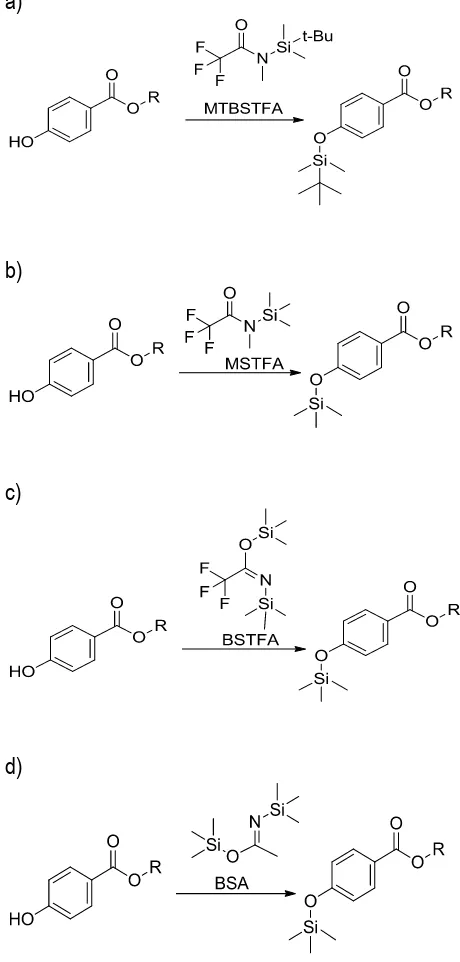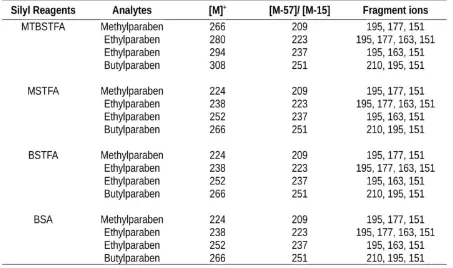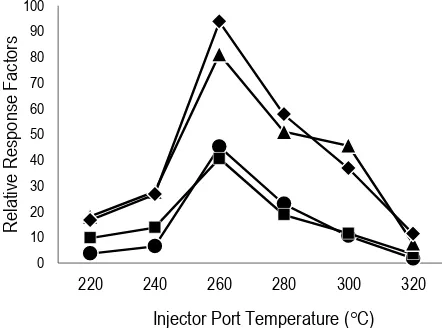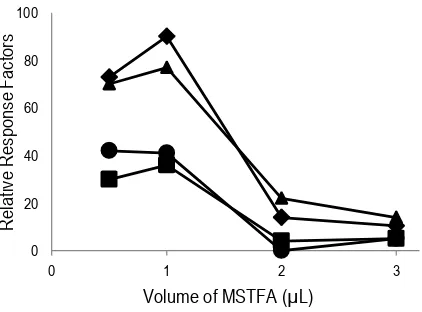5 : 2 (2016) 55-62ǀ ALCHEMY: Journal of Chemistry ǀ EISSN 2460-6871
Journal of Chemistry
Research Article
Optimization of Silylation for Parabens Determination by Gas
Chromatography-Mass Spectrometry
Rosalina Djatmika1,2*, Wang-Hsien Ding2
1 Department of Chemistry, Faculty of Mathematics and Natural Sciences, Brawijaya University, Malang, Indonesia 2 Department of Chemistry, National Central University, 300 Jhong-Da Road, Jhong-Li, Taoyuan, Taiwan
ARTICLE INFO ABSTRACT
Article history
Revised 29 September 2016 Accepted 24 October 2016 Available online 1 November 2016
A low cost, environmental friendly and convenient method for parabens derivatization using Gas Chromatography-Mass Spectrometry (GC-MS) analysis is investigated. Derivatization is needed to enhance the thermal stability, detectability, and volatility of parabens to make them amenable for gas chromatographic analysis. This method involved on-line derivatization by silylating reagent: N-Methyl-N-tert-butyldimethylsilyltrifluoroacetamide (MTBSTFA), N,O-bis (trimethylsilyl) trifluoroacetamide (BSTFA), N-methyl-N-trimethylsilyltrifluoroacetamide (MSTFA), and N,O-bis(trimethylsilyl)acetamide (BSA). The variables affected the derivatization process, such as, types and volumes of silylating reagents, injection port temperature, and purge-off time, were evaluated to obtain the optimal condition for determination of parabens. The Relative Response Factors (RRF) was used as a parameter of parabens derivatization efficiency to obtain the best compromise condition of each variable. On a comprehensive level, a comparison of the optimal condition of each silylating reagent was evaluated. Moreover, 1 µL of MSTFA at 260°C of injection port temperature and 2.5 min purge-off time (in splitless mode) obtained the most effective of derivatization process.
Keywords: Parabens, on-line silylation, Gas Chromatography-Mass Spectrometry
*Author corresponding
Email: [email protected]
1. Introduction
Parabens or esters of p-hydroxybenzoic acid that include methylparaben (MP), ethylparaben (EP), propylparaben (PP) and butylparaben (BP) are commonly used as antimicrobial preservatives in cosmetics, food, industrial and pharmaceuticals products due to their low toxicity, low cost, inert nature and worldwide regulatory acceptance (Han, Xia, Chen, Shen, Miao, & Shen, 2016). The widespread use of parabens causes their ubiquitous existence in environment. Parabens have been found in indoor dust (Tran, Minh, Kumosani, & Kannan, 2016), surface water
56
reported that parabens have endocrine disruptive effect which cause human male reproductive disorders and play a role in enhance the risk of
breast cancer (Shanmugam, Ramaswamy,
Radhakrishnan, & Tao, 2010). Because of parabens have potential health effects of endocrine disrupting factors, developing method for parabens analysis got great interest.
Gas chromatography–mass spectrometry (GC–
MS) is commonly used for identification and
separation parabens. To improve GC
chromatographic separation, derivatization is typically used to increase the volatility of parabens and to improve sensitivity (Bowden, Colosi, Mora-Montero, Garret, & Yost 2009). However, derivatization reactions commonly are performed off-line, but it needed multi-step reactions, long time-consuming, and used toxic reagents (Wang,
Ma, Yin, & Xu, 2013). On-line
derivatization reduces solvent waste, simplifies sample preparation, and avoids the need for hazardous reagents (Wu, Hu, Yue, Yang, & Zhang, 2009).
On-line silylation was a derivatization using silylation reagent which developed and applied for
the analysis of parabens with GC–MS. Silylation is
the most commonly used in derivatization procedures for GC-MS analysis since it could improve the GC sensitivity, accuracy and resolution by enhancing thermostability, detectability and decreasing peak tailing (Wang et al., 2013). The active hydrogen on hydroxyl groups of parabens is replaced with silyl groups of the silylation reagent during derivatization process. There are many kinds of silylation reagents, such as N-Methyl-N-tert-butyldimethylsilyltrifluoroacetamide (MTBSTFA),
N,O-bis (trimethylsilyl) trifluoroacetamide
(BSTFA),
N-methyl-N-trimethylsilyltrifluoroacetamide (MSTFA), and N,O-bis(trimethylsilyl)acetamide (BSA) which play important role in the derivatization efficiency. The
derivatization factors affected derivatization
efficiency, such as the types and volumes of silylating reagent, injection port temperature, and purge-off time were also investigated.
2. Materials and methods
2.1. Materials
All chemicals are analytical grade and used without further purification: methylparaben (Alfa Aesar), ethylparaben (Alfa Aesar), propylparaben
(Alfa Aesar), butylparaben (Alfa Aesar), p
-Terphenyl-d14 as an internal standard
(Sigma-Eldrich), dichloromethane (Macron), methyl alcohol (Merck), acetone (Macron), acetic anhydride (Sigma-Aldrich), and deionized water, Milli-Q water produced by Millipore Elix 10 RO system and a Millipore Synergy UV system. The silylation
derivatization reagents used:
N-Methyl-N-tertbutyldimethylsilyltrifluoroacetamide (MTBSTFA),
N,O-bis(trimethylsilyl)- trifluoroacetamide
(BSTFA),
N-methyl-N-trimethylsilyl-trifluoroacetamide (MSTFA), and
N,O-bis-(trimethylsilyl)-acetamide were purchased from Sigma-Aldrich.
2.2. Preparation of stock solutions
All solution used in this experiments was prepared using microsyringes to measure accurately which conditioned before by rinsing the syringes with dichloromethane, acetone, and methanol. The methylparaben stock solution was made by dissolving 10 mg of methylparaben solid standard with 10 mL methanol to make 1000 ppm of methylparaben (MP). The same procedure was
applied to prepare ethylparaben (EP),
propylparaben (PP), and butylparaben (PP) stock solutions. The internal standard stock solution was prepared by dissolving 10 mg of internal standard with 10 mL dichloromethanes. These stock solutions were stored at 4°C in the dark to prevent degradation by light. A stock solution of internal standard was prepared by dissolving mg of 10 mg
p-Terphenyl-d14 in 10 mL dichloromethane to make
1000 ppm.
2.3. Preparation of working solutions
The working solution was prepared by diluting stock solution. To prepare MP, EP, PP, BP, and internal standard working solution, the stock solutions of parabens standard was diluted with methanol and internal standard stock solution was
diluted with dichloromethane until reach
concentration 1.0 ppm of MP, EP, PP, and BP.
2.4. GC-MS analysis
Analysis was performed by gas
chromatography-mass spectrometry (GC-MS)
system: Varian 450 GC directly connected to a Varian 220 ion-trap mass spectrometer (Walnut Creek, CA, USA) operated in electron ionization (EI) which set to full scan at mass range 100-500
57
chromatography column used was DB-5MS
capillary column (30x0.25 mm i.d., 0.25 μm film
thickness). A ChromatoProbe (Varian) was used to introduce large-volume samples for on-line silylation. High purity helium (99.999%) at a flow rate of 1 mL/min was used as carrier gas.
The transfer line and ion source temperatures were set to 250 and 180°C, respectively. Oven temperature was programmed to begin at 100°C
for 4.0 min, increased by 25C/min to 300°C and
maintained for 3 min. The injection-port temperature was held at 260°C for 2.5 min in order to complete silylation reaction and solvent vaporisation, then the temperature was accelerated
rapidly to 300C for silylated derivatives
introduction into the analytical column.
2.5. On-line silylation procedure
Each sample solution contained standard mixed of 4 types of parabens (methylparaben, ethylparaben, propylparaben and butylparaben). In
a typical run, 10 μL volume of standard parabens
mixed containing internal standard solution was added various silylating reagent in different volume. The mixing solution then introduced into a micro-vial, the vial was took into a ChromatoProbe vial holder, and then placed in the GC injection-port to
obtain on-line silylation. Important silylation
parameters, such as types and volumes of silylating reagent, injection port temperature and purge-off time were investigated to obtain the optimal condition of silylation process.
3. Result and discussion
3.1. GC-MS analysis of on-line silylation
Parabens are polar and thermally fragile compounds thus need derivatization to convert into more volatile compound for GC-MS analysis. Derivatization turned them into less polar, thermally stable and more volatile compounds for GC-MS analysis. Silylation is a derivatization procedure which substitute active hydrogen of the hydroxylated molecule with a silyl group of silylating reagent. Silylation reagents will convert hydroxyl alcohol to form tertiobutyldimethylsylil- (TBDMS) ethers (for derivatizations with MTBSTFA) and trimethylsilyl (TMS) ether (for derivatizations with
BSTFA) via SN2 substitution reaction, resulting a
derivative for each compound. The silylated derivatives formed are volatile and for the most part, are easily separated (Scott, 2003). Fig. 1
displays the reactions of parabens with various silylating reagents (MTBSTFA, MSTFA, BSTFA, and BSA). The success of on-line silylation was evaluated with the appeared of molecular ion of silylated derivatives. Table 1 summarises the molecular ion and the fragment ions for each silylated derivatives observed in mass spectra.
a)
b)
c)
d)
Fig. 1. The reactions of parabens with various silylating reagents: a) MTBSTFA, b) MSTFA, c) BSTFA, d) BSA.
Molecular ions ([M]+) showed in Table 1 is the
58
MTBSTFA-derivatives. Whereas for MSTFA, BSTFA, and BSA derivatization, [M-15] is corresponding to the loss of methyl group. The loss of tert-butyl and methyl group resulting silylated derivatives possessed good thermal and hydrolytic stability (Wang et al., 2013). Ion at 195 m/z
([(CH3)3SiO-Ar-CO + 2H]+) observed in all of
molecule was confirmed by loss of tert-butyl group
(for MTBSTFA derivate) or –CH3 group (for other
silylated derivatives) of the Si(CH3)3 and by loss of
–(CH3)n (n=1 to 4 for MP, EP, PP, and BP).The
intense signals detected in MS spectra were ions of m/z 151, 163 and 177 which attributed to the loss
of CO2 (carbondioxide), O2 (oxygen) and H2O
(water), respectively.
Table 2.
The optimal condition of each silylating reagent Silylating
Reagent
Temperature of
Injection-port (˚C)
Derivatization Time (min)
Silylating Reagent
Volume (µL)
MSTFA 260 2.5 1.0
BSA 300 3.0 2.0
BSTFA 280 2.5 2.0
MTBSTFA 300 2.0 1.0
Table 1.
The molecular and the fragment ions for each silylated derivatives observed in mass spectra.
Table 3.
59
220 240 260 280 300 320
R
Injector Port Temperature (°C)
0
3.2. Optimisation of the silylation
Optimisation of the silylation was evaluated using standard mixed of parabens consisted of examining injection-port temperature, purge-off time, and volume of silylating reagent with various silylating reagents: MTBSTFA, MSTFA, BSTFA, and BSA. The optimal condition of injection-port temperature, purge-off time, and volumes of silylating reagent of each reagent was used for comparison, as shown in Table 2. The RRF was used as a derivatization efficiency parameter to evaluate the best compromise condition of each variable. Table 3 shows RRF of the optimal condition for each silylating reagent.
According to Table 2 and Table 3, MSTFA and BSTFA as silylating reagents have good RRF due to both are appropriate reagent choice for derivatization of hydroxylated compounds (Bowden et al., 2009). Otherwise, MSTFA offers better compromise condition than BSTFA since it had higher RRF values than others and only required
1.0 µL of MSTFA reagent for 2.5 min for silylation
reaction and offers acceptable reproducibility. This result was corresponding with previous study mentioned that MSTFA is more potent and selective trimethylsilyl donor for reactions, mainly with OH groups, thus it could give good RRF for parabens derivatization (Wu, & Lee, 2006).
3.3 Injection-port temperature
Injection-port temperature had effect to the derivatization efficiency as it thermally catalyse the derivatization reaction process. The various injection-port temperatures ranging from 220 to
320C (at 20C increments) were examined at a
2.5 min purge-off time. As shown in Figure 3, the RRF values of TMS-derivatives enhanced gradually when the injection-port temperature was increased from 220-260°C, but thereafter it decreased
significantly. Therefore, in this study, 260C was
chosen as the optimised injection-port temperature. It was corresponding with some previous study which reported that the injection-port was set between 250 to 300°C to obtain fast and completely reaction (Wang et al., 2013). The high temperature could overcome the energy barrier of the reaction and steric interference, thus made increasing of the reaction efficiency (Wu & Lee, 2006). Otherwise, a too high temperature could reduce analytical signals due to derivatives decomposition (Wang et al., 2013). In the other
side, a low injection-port temperature resulted the low of GC signal because the analytes did not
Other parameter influenced the on-line silylation process is the purge-off time, which evaluated for 1.5, 2.0, 2.5, 3.0, and 3.5 min in splitless mode with injection-port temperature at
260C. It was observed that RRF values increased
with increasing purge-off time from 1.5 to 2.5 min, then decreased with the purge-off time increasing to 3.5 min (shown in Figure 4). A possible reason of the decreasing RRF during the longer time is that
the produced solvent “cloud” in the injector after a
60
as the optimised purge-off time that analytes got highest RRF at this value. This result agreed with
Ho’s study which reported 2.5 min gave the highest yield for on-line silylation process (Ho & Ding, 2012).
3.5. Volumes of derivatization reagent
The volume of derivatization reagent had also a significant effect on the derivatization efficiency. The excessive of the volume of silylating reagent could disturb the analytes separation, thus led the reduction of derivatization efficiency (Toledano, Cortes, Andini, Vazquez, & Villen, 2012). As well as the insufficient of silylation obtain poor separation due to incompletely derivatization (Basheer, Parthiban, Jayaraman, Lee, & Valiyaveettil, 2005). In this present work, the volume of silylation reagent was varied, 0.5; 1.0; 2.0 to 3.0 µL. When 0.5; 2.0 and 3.0 µL were used, the poor peak resolution was observed, as shown in Figure 5. Therefore, 1.0 µL was selected as the best volume of silylating reagent.
chromatography-mass spectrometry. On-line
silylation appears to be a promising method for parabens derivatization due to it is low cost, environmental friendly and convenient method.
MSTFA
(N-methyl-N-trimethylsilyl-trifluoroacetamide) was selected as the most effective silylating reagent for derivatization of
parabens. Many factors influenced the
derivatization process, such as, injection-port temperature, purge-off time and the volume of
silylating reagent were optimised, resulting the good derivatization efficiency which conditioned by 260°C of injection-port temperature for 2.5 min under contract No. MOST 103-2113-M-008-005-MY2. The authors thank to the Instrumental Center
of National Central University for the
instrumentation support. We also thank to Chih-Chung Hsieh and Jhih-Ming Chen who helped the author to do this research.
6. References
Azzouza, A., Rascon, A.J., & Ballesteros, E. (2016). Simultaneous determination of parabens, alkylphenols, phenylphenols, bisphenol A and triclosan in human urine, blood and breast milk by continuous solid-phase extraction and gas chromatography-mass
spectrometry. Journal of Pharmaceutical
and Biomedical Analysis, 119, 16-26.
doi:10.1016/j.jpba.2015.11.024
Basheer, C., Parthiban, A., Jayaraman, A., Lee,
H.K., & Valiyaveettil, S. (2005).
Determination of alkylphenols and
bisphenol-A: a comparative investigation of
functional polymer-coated membrane
microextraction and solid-phase
microextraction techniques. Journal of
Chromatography A, 1087(1-2), 274-282.
doi:10.1016/j.chroma.2005.03.014
Bowden, J.A., Colosi, D.M., Mora-Montero, D.C., Garret, T.J., & Yost, R.A. (2009). Enhancement of chemical derivatiozation of steroids by gas chromatography/mass
spectrometry (GC/MS). Journal of
Chromatogrphy B, 877(27), 3237-3242.
Elie, M.P., Baron, M.G., & Birkett, J.W. (2012).
Injection port silylation of γ-hydroxybutyrate and trans-hydroxycrotonic acid: conditions optimisation and characterisation of the di-tert-butyldimethylsilyl derivatives by
61
Ferreira, A.M., Moder, M., & Laespada, M.E. (2011). Stir bar sorptive extraction of parabens, triclosan and methyl triclosan from soil, sediment and sludge with in situ derivatization and determination by gas
chromatography-mass spectrometry. paraben-type preservatives and three benzophenone-type ultraviolet light filters
in seafoods by LC-QqLIT-MS/MS. Food
Chemistry, 194(1), 1199-1207.
doi:10.1016/j.foodchem.2015.08.093 Hines, E.P., Mendola, P., van Ehrenstein, O.S., Ye,
X., Calafat, A.M., & Fenton, S.E. (2015). Concentrations of environmental phenols and parabens in milk, urine and serum of
lactating North Carolina women.
Reproductive Toxicology, 54, 120-128.
doi:10.1016/j.reprotox.2014.11.006
Ho, Y.C., & Ding, W.H. (2012). Solid-phase
extraction coupled simple on-line
derivatization gas chromatography -
tandem mass spectrometry for
determination of benzophenone-type UV
filters in aqueous samples. Journal of the
Chinese Chemical Society, 59(1), 107-113.
doi:10.1002/jccs.201100317
Liao, C., Chen, L., & Kannan, K. (2013). Occurrence of parabens in foodstuffs from China and its implications for human
dietary exposure. Environment Intertional,
57-58, 68-74. Environmental Specimen Bank from
1995-2012. International Journal of Hygiene and
Environmental Health, 218(7), 666-674.
doi:10.1016/j.ijheh.2015.07.005
Rocio-Bautista, P., Martinez-Benito, C., Pino, V., Pasan, J., Ayala, J.H., Ruiz-Perez, C., & Afonso, A.M. (2015). The metal-organic framework HKUST-1 as efficient sorbent in a vortex-assisted dispersive micro solid-phase extraction of parabens from environmental waters, cosmetic creams,
and human urine. Talanta, 139(1), 13-20.
doi:10.1016/j.talanta.2015.02.032.
Rodas, M., Portugal, L.A., Avivar, J., Estela, J.M., & Cerda, V. (2015). Parabens determination in cosmetic and personal care products exploiting a multi-syringe chromatographic (MSC) system and chemiluminescent
detection. Talanta, 143(1), 254-262.
doi:10.1016/j.talanta.2015.04.055
Scott, R. P. (2003). Gas chromatography, Book 2,
Chrom-Ed Book Series. Retrieved
September 20, 2016, from
http://www.library4science.com/eula.html2
Shanmugam, G., Ramaswamy, B.R.,
Radhakrishnan, V., & Tao, H. (2010). GC-MS method for the determination of paraben preservatives in the human breast
cancerous tissue. Microchemical Journal,
96(2), 391-396.
doi:10.1016/j.microc.2010.07.005
Toledano, R.M., Cortes, J.M., Andini, J.C., Vazquez, A., & Villen, J. (2012). On-line derivatization with on-line coupled normal
phase liquid chromatography-gas
chromatography using the through oven transfer adsorption desorption interface: application to the analysis of total sterols in
edible oils. Journal of Chromatography A,
1256, 191-196. doi:
10.1016/j.chroma.2012.07.057
Tran, T.M., Minh, T.B., Kumosani, T.A., & Kannan, K. (2016). Occurrence of phthalate diesters (phthalates), p-hydroxybenzoic acid esterx (parabens), biphenol A diglycidyl ether (BADGE) and their derivates in indoor dust from Vietnam: Implications for exposure.
Chemosphere, 144, 1553-1559.
62
Wang, Q., Ma, L., Yin, C.R., & Xu, L. (2013).
Developments in injection port
derivatization. Journal of Chromatography
A, 1296, 25-35. doi:
10.1016/j.chroma.2013.04.036
Wu, J., & Lee, H.K. (2006). Injection port derivatization following ion-pair hollow fiber-protected liquid-phase microextraction for determining acidic herbicides by gas
chromatography/mass spectrometry.
Analytical Chemistry, 78(20), 7292-7301.
doi:10.1021/ac060966e
Wu, J., Hu, R., Yue, J., Yang, Z., & Zhang, L. (2009). Determination of fecal sterols by gas chromatography-mass spectrometry with solid-phase extraction and
injection-port derivatization. Journal of
Chromatography A, 1216(7), 1053-1058.



